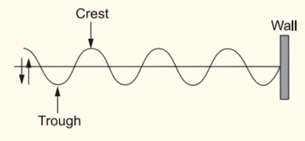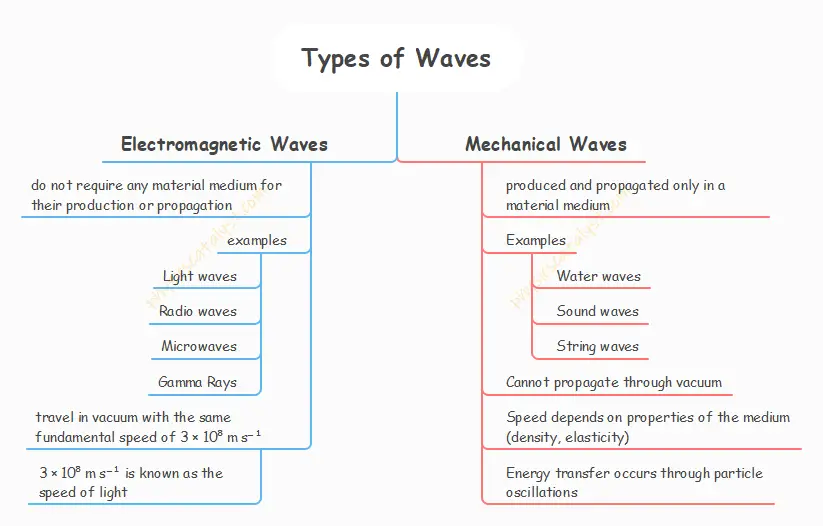

Comprehensive Class 11 Physics notes about Introduction to Waves in Physics where we covering wave motion essentials including types of waves, wave terminology, and fundamental properties. Students will learn about mechanical, electromagnetic, and matter waves with detailed explanations of amplitude, frequency, wavelength, and wave equations. Ideal for CBSE Class 11 curriculum and competitive exam preparation for NEET and JEE Main physics sections.
Wave is the propagation of disturbance in a medium without the actual transfer of matter. When a wave travels through a medium, the particles of the medium oscillate about their mean positions, but the medium as a whole does not move from one place to another.
A medium in wave motion is the substance or material that allows a wave to travel from one place to another. It is important to note that, the medium does not become the wave itself but just acts as the transporter of the wave’s energy.
Key Points about Medium in Wave Motion
A medium is the material or substance through which a wave propagates.
It acts as the carrier of the wave but does not create the wave itself.
The particles of the medium do not travel with the wave; instead, they usually vibrate about their mean positions, transferring the disturbance (energy, not matter) along the medium.
Different types of waves require different media:
Examples of wave media:
A medium for a wave is like a messenger: it does not create the message, and it is not the message itself. It only carries the wave (energy) from one location to another.
Take a string and tie one end to a rigid support like a wall, while holding the other end in your hand. When you move your hand up and down, a disturbance is created in the string which moves from one end (your hand) to the other end (the wall).
Key Observations:

This demonstrates that the wave carries the disturbance without transporting the medium itself.
Consider throwing a pebble into calm water of a lake. The disturbance created spreads outward in concentric circles with constant speed until reaching the boundary.
Important Observation: The water in the lake is not flowing away from the disturbance point. Instead, water particles oscillate up and down in the same location while the disturbance pattern moves outward.

If a cork is placed on the water surface during wave propagation, it oscillates up and down but does not move away from its original position. This demonstrates that the medium (water) is not flowing, but rather the disturbance is being transferred.
When a disturbance is created at any point in an elastic medium, it advances through the medium with constant speed, but the medium as a whole does not move. Only the disturbance pattern propagates.
When disturbance occurs at a point in an elastic medium :
The wave motion involves transmission of energy and momentum from one point to another without matter transfer. This is fundamentally different from material particle motion where the object physically moves from one location to another.
Physics recognizes two distinct types of waves based on their fundamental characteristics and propagation requirements.
Mechanical waves are waves that can be produced and propagated only in a material medium. These waves cannot exist without matter and require the presence of particles to transfer energy from one point to another.
Electromagnetic waves do not require any material medium for their production or propagation. These remarkable waves can travel through vacuum as well as through material substances.
All electromagnetic waves travel in vacuum with the same fundamental speed of 3 × 10⁸ m s⁻¹ (approximately 300,000 kilometres per second). This speed, known as the speed of light, represents one of the most important constants in physics.

These terms given below form the foundation for all wave-related calculations and understanding various wave phenomena.
Amplitude represents the maximum displacement of a vibrating particle on either side of its mean position. This is one of the most important characteristics of any wave motion.
Key Points about Amplitude:
Frequency is defined as the number of oscillations per second performed by the particles of the medium. It represents how often the wave pattern repeats itself.
Important Characteristics:
Phase describes the state of motion of a particle in the medium at a given point and given time. This concept helps understand the relative motion of different particles.
Phase Information Includes:
Time period of a wave is the time taken for particles of the medium to complete one full oscillation. It represents the duration of one complete wave cycle.
Key Features:
Wavelength is the minimum distance between two particles of the medium which are in the same phase of vibration. This defines the spatial extent of one complete wave pattern.
Alternative Definition: Wavelength can also be defined as the distance traversed by the disturbance in one time period (T).
Specifications:
Wave velocity represents the speed with which the wave propagates through the medium. This is fundamentally different from particle velocity.
Mathematical Relationship: If v is the wave velocity, λ is the wavelength, and T is the time period:
\(\lambda = v \cdot T = v \cdot \frac{1}{f}\)
Therefore: \(v = f\lambda\)
Where \(f = \frac{1}{T}\) is the frequency.
Wave vector or propagation constant is 2π times the number of waves contained in unit length. This quantity helps in mathematical analysis of wave motion.
Mathematical Expression: \(k = \frac{2\pi}{\lambda}\)
Properties:
Fundamental Wave Equation: \(v = f\lambda\)
Frequency-Period Relationship: \(f = \frac{1}{T}\)
Wave Vector Relationship: \(k = \frac{2\pi}{\lambda}\)